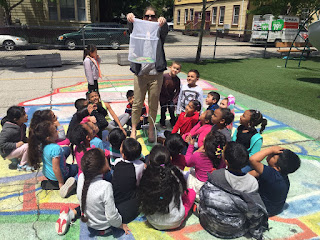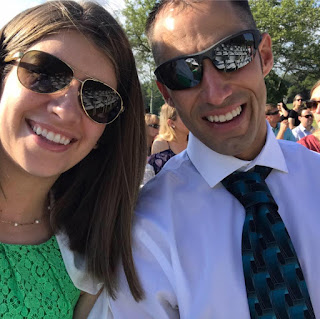Who Am I? What I believe
The Written Assignment
Kindergarten is my world.
Kinder es mi mundo. I have been an early childhood educator for eight years. I
have learned, cried, taught, and loved. My students enter my classroom as
babies and leave as children.
My children are blank slates.
They come from backgrounds unforeseen by most; they have difficulty in
communicating as they were never taught how to talk and how to share. At
school, we teach them in their home language and a new language; whether that
be English and Spanish or Spanish and English. We are changing their lives;
expanding their horizons; creating bilingual and bi-literate humans. We are
their beginning. We set the foundation for their years to come. Without us,
they fall between the cracks; their foundational skills are missing; they do
not know anything about who they are.
I don’t teach to teach. I teach
to impact. To create. To explore. To laugh. Like Kelly Reed, I make the time to
allow students to create. They are kindergarteners; their lives are a hands-on
process. Just like Robinson, I believe that humans, especially children are
naturally curious and creative. These curious little humans are engaged if they
find the content in front of them meaningful and useful in their daily lives.
I have been in my position for
five years. I entered the building I work in with only tables in my classroom.
Now, it is a dynamic work and play space for children to explore and engage.
Every year, we add a new piece of technology. We connect our 1904 built
building to the current day; the current society in which we live. We began
with two iPads in every classroom five years ago. Now, entering the new school
year, over half of us will have SmartBoards; each early childhood classroom
will have ten devices a piece; and every upper elementary classroom has a
one-to-one ratio of Chromebooks for their departmentalized classrooms. Yet, we are still behind.
The educators in my building
are mostly digital immigrants. These teachers and staff were born in a time
where the technology we have today was not yet invented. The children that we
teach are digital natives. Together, we are all different learners. As Prensky
makes us aware, we as educators should know what our students know and know who
they are in today’s world. This can be a determining factor in how students
learn from us as educators and how they feel about what we know.
We need to engage ourselves in
their technological world. Not one of the teachers in the building has a
classroom website; a handful use Class Dojo; most use the programs purchased by
the district, Lexia and Dreambox. Past that point, the educators in the
building are unaware of how to handle new technology. They want to know what
they want to know and that is it. In this sense, we are not showing our
students that we are lifelong learners. We are stagnant. It is time for a
change.
I began to think how would I
make this change? I thought that I was ahead of the curve in my school. I
figured that I had a decent amount of technology in my classroom and I was the
go-to person on our kindergarten team for technology problems. I even help the
principals. I considered myself a tecno-constructivist. I used Lexia and
Dreambox to support my daily lessons. I had the students explore with coding
every Friday. Yet, enrolling in Digital Media Literacy and learning from those
around me, I have seen that I did not know as much as I thought I did. I am at
best, a techo-traditionalist. I can use technology in my classroom to an
extent…I mean, I am a digital immigrant…I know the basics-Facebook, Snapchat, a
Google Doc, but the rest…was an unknown. It scared me. I am learning of a huge
world. The butterfly trapped in her net.
So, the question then lied
where do I go from here? I have learned so much from those around me in one
week and I have known that I needed to make the push for technology in my
school. I thought of maybe creating something to teach my colleagues how to use
some of the tools that I have learned about and/or some of the tools that I had
already used. But then I began to think of my own classroom issues. Would it be
more impactful to tackle those?
For years, I have had trouble
with family involvement. Well, let me rephrase that. Our school has had trouble
with family involvement. We have tried everything…food functions, guests, free
stuff…and still, nothing. The same 50 people come each time. This past year I
began to have a few relationships with some families in my classroom. I really
got to know them. So, I asked them what would be most beneficial for them from
me? Is the folder filled with papers something they look at each day? Do they
look at emails? Texts? Family involvement is essential in student learning;
especially in the learning of young kindergarteners.
So, I have begun a classroom
website for my co-teacher and myself in Dual Language Kindergarten. I am
getting the ball rolling, as they say. I want to impact the lives of my young
students, their families, and my colleagues. I want to change the technological
culture at Carl G. Lauro. I want to bring us into the digital world that we
teach and know on a daily basis.
The website will allow families
to be involved in the everyday life of our classroom. It will have a page
dedicated to English learning, a page dedicated to Spanish learning, a page
dedicated to our schedule (both daily and weekly) as well as the lunch menu
link, and a page with resources to help in language acquisition whether it be
English or Spanish. Families will be linked to other online resources as well,
like report cards, our email addresses, and the school website.
Turkle stated the importance of
conversation and that dialogue leads to learning. Even without a human
connection as I needed in the past, I am using technology as a tool to have
conversations with parents through our classroom website. While these conversations
will no longer be a direct back-and-forth dialogue, I will be able to engage
with parents that I would normally never meet in each school year.
I am hoping that this website
will impact the families that are a part of our classroom and that this will be
a stepping stone for family involvement in the school building. Using
technology to address families is a way to come into their daily lives on their
smartphones and involve them in the education of their child.
Susan Patterson discussed how
there is a curated environment on the internet, how empathy is the basis to
build conversation, and the best way to teach is to learn. I am learning how to create digital tools for
the classroom. My technology horizons are
expanding not only for the classroom but for the professional development that
I present. It will allow me to change the landscape of thinking for colleagues,
update our school, and come in line with the ways our students are thinking and
learning.
It is never known the power
that one person can have to change the way others and the world think. Technology
in the classroom is allowing me to do so as I alone make the little ones’
count.
P.S.
I swear…I’m not a zookeeper!


Comments
Post a Comment